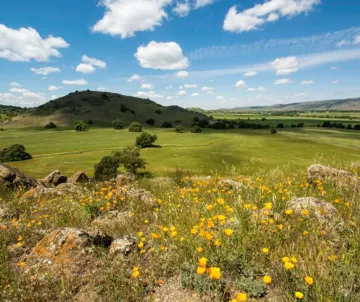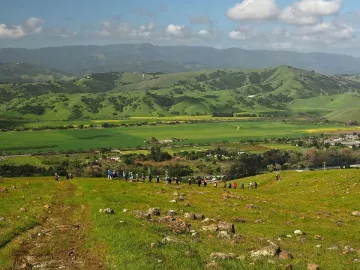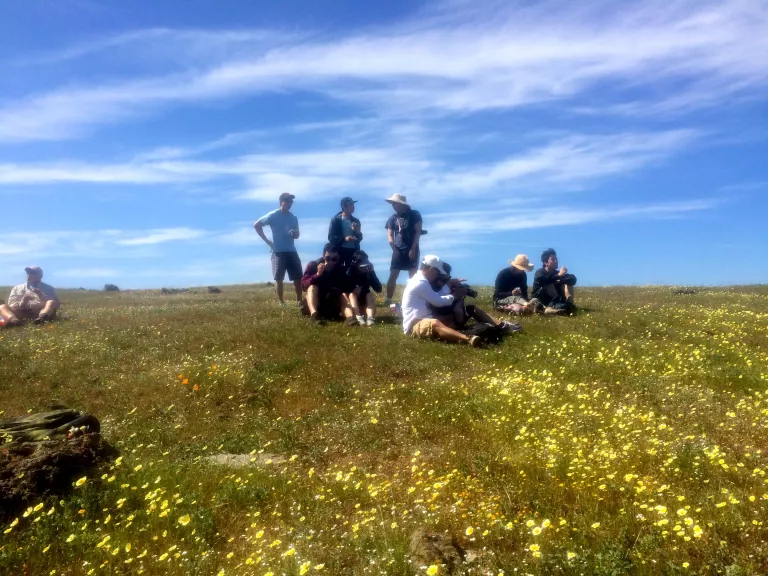
Coyote Valley Open Space Preserve is more than 7000 acres of the most beautiful and environmentally important area in San Jose, but it is at risk of development that would jeopardize a vital wildlife corridor, put San Jose’s groundwater supply at risk, eliminate some of the best remaining farmland in the county, and effectively cripple San Jose’s goal of substantially reducing its greenhouse gas emissions.
Development of Coyote Valley would jeopardize San Jose’s groundwater supply. The high porosity of the soils and drainage patterns make the aquifer that provides water for many people in San Jose extremely vulnerable to contamination.
Coyote Valley has been documented as a key wildlife corridor that is needed to avoid genetic isolation of populations which could result in the eventual loss of several sensitive species. The valley is also essential to San Jose’s plans to reduce greenhouse gas emissions. Open space, trees, and agricultural fields absorb CO2 but an industrial area with warehouses and diesel trucks produce CO2.
Additionally, Coyote Valley is a last vestige of the “Valley of Heart’s Delight”, whose beauty and cultural history should be protected for the respect, benefit and enjoyment of all people.
Value as Wildlife Linkage
A De Anza College study of the area concluded:“There is scientific consensus that Coyote Valley is one of the last critical links between the Diablo and Santa Cruz mountain ranges.”Bobcats, Mountain Lions, Badgers, and many other species have been photographed or identified in the area. Wildlife is already using culverts to cross Highway 101 and those crossings could be made even more effective. Threatened species, including Swainson’s Hawks, have been observed both nesting and foraging in the valley. The valley is an extremely important wintering area for many bird species which prefer the flat valley floor over mountainous areas.
Value as Water Supply
Coyote Valley acts essentially like a 7500-acre percolation pond and is the de facto forebay for the Santa Clara Groundwater Basin, which serves some 2 million residents and businesses in Santa Clara County. For millennia, the Coyote Valley received the alluvial deposits from the upstream 200 square miles of the Coyote Watershed. These alluvial deposits consisted primarily of larger sands and gravels of high porosity and transmissibility. Because of this high porosity, horizontal movement down gradient north toward San Jose through the Coyote Valley has been measured at 10 feet per day. The basin is connected with and greatly influences the stream flow of the main stem of the Coyote Creek and vice versa. Pat Ferraro, an instructor in water policy at San Jose State University and former board member of the Santa Clara Valley Water District concludes that the valley should not be developed and organic agriculture should be encouraged in order to safeguard our water supply.

Value as Farmland
The valley contains some of the last quality farmland near San Jose which should be protected as an important resource for the residents.
Value as Flood Control
As was clearly shown during the 2017 Coyote Creek flooding in San Jose, the situation could have been substantially worse if Coyote Valley had been paved and so not able to slow and absorb the excess water.
Current Situation
Coyote Valley has survived many attempts at development over the years and it is, perhaps, a miracle that it still exists as it does. Coyote Valley is divided into three zones. South Coyote Valley is designated open space, but, ironically, is the most developed, including residential and industrial.
Mid and north valley are less developed, and most valuable for wildlife and agriculture, but are at risk due to zoning designations that envision development. Thanks to Chapter activists and partners, Mid-valley is off limits until 2040, so the latest proposed developments are in the north.
Threats
We can rejoice that a proposed 30 acre Panattoni Corporation warehouse/distribution center was recently dropped and the land was sold to Peninsula Open Space Trust. However, the purchase of 570 acres by Brandenburg Properties could transform rare valley floor open space into a busy industrial area with big rig traffic, parking lots, and all the associated noise, air, water and soil pollution.
If San Jose is serious about climate change and CO2 reduction, industrial development of Coyote Valley is the last thing it should do.
Will this valley become largely indistinguishable from the rest of the Bay Area’s urban sprawl, or will it be permanently preserved for its ecological, cultural and historical significance?
Support the Loma Prieta Chapter activism educating the public and elected officials about the importance of protecting Coyote Valley. Become a member, donate to our conservation programs, and help one of our conservation teams described on our website.
